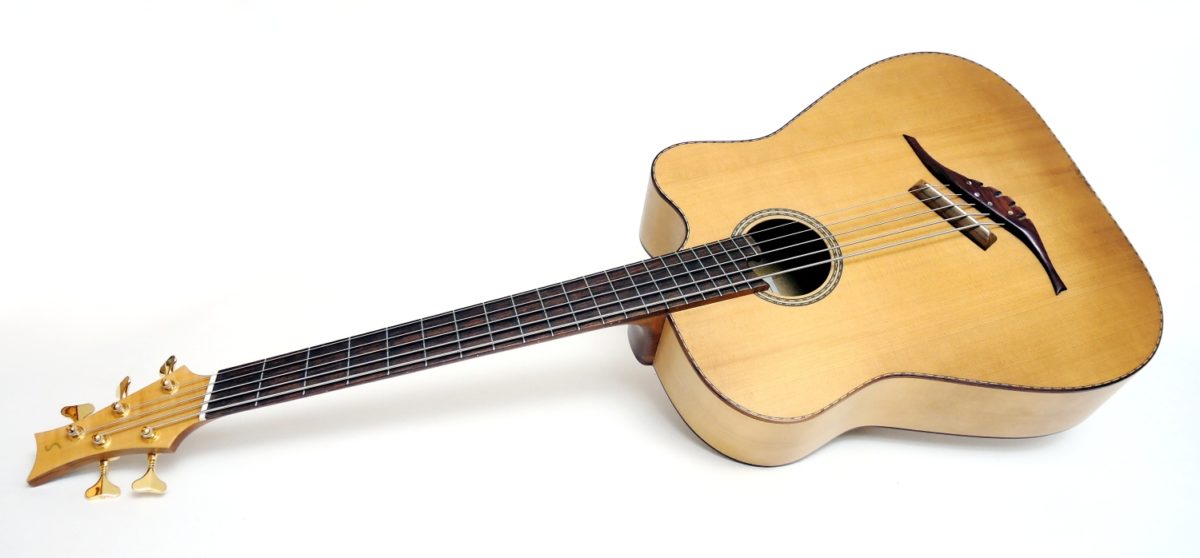Magazine: Guitar Acoustic 05/2013 | Author: Jürgen Richter
Of all instruments called acoustic bass, Stoll's is the largest. Now there is a rather slanted version, which at least carries the intelligent addition IQ...
 Bass needs space. Physics cannot be outsmarted. That is why acoustic basses do not exist. Why not? The body is too small. Assumptions which apply to practically all "acoustic basses" available on the market were never of interest to Christian Stoll. He simply enlarged the body of his acoustic bass until a decent bass tone emerged. Now he takes the next physical hurdle, namely the scale length. The longer the scale, the more freely a thick low string can vibrate, but the more uncomfortable the instrument is to play. Double basses sometimes come along with scales of clearly over one metre.
Bass needs space. Physics cannot be outsmarted. That is why acoustic basses do not exist. Why not? The body is too small. Assumptions which apply to practically all "acoustic basses" available on the market were never of interest to Christian Stoll. He simply enlarged the body of his acoustic bass until a decent bass tone emerged. Now he takes the next physical hurdle, namely the scale length. The longer the scale, the more freely a thick low string can vibrate, but the more uncomfortable the instrument is to play. Double basses sometimes come along with scales of clearly over one metre.
Stoll did not want to go that far; he gave his new bass a 92 scale length - but only to the low B-string. The G-string has the standard bass scale length of 86 cm, the remaining string lengths are divided in between. This system is called "acoustic bass". It requires angled frets, the so-called Fanned Frets, and results in a visually unusual fingerboard. The eighth fret is "straight", the others are adjusted accordingly. This also causes the bridge to be enormously skewed. By the way, the bridge is not fixed, so it can be moved to adjust the compensation - as far as the cable of the built-in McLoud pickup in the bridge allows. For those who have not yet noticed: This IQ Bass is a five-string bass, but is also available with four and even six strings.
So Far, So Unusual
The neck of the IQ Bass is made of Spanish Cedar, a wood commonly used for classical guitars. The neck profile is very flat, although the neck itself is not excessively thin. This makes it look like the neck of a classical guitar. The neck-body joint is also borrowed from this tradition; the neck extends into the body and thus forms the top block. So far, so unusual.
Stoll constructs his bass around a top made of solid Spruce. He needs enormous quantities for this purpose; one can hardly believe that a Spruce tree can be so thick. As with a normal acoustic guitar (or even a double bass) you find here two pieces of spruce joined together in the middle, which also have a striking grain exactly in the bridge position. Back and sides are made of maple. Although there are similarly wide maples on the market, Stoll uses a three-piece construction. A three-part back has been considered more bass heavy since Martin's model D-35 at the latest. That may be, but the main reason is the greater stability of the three-part back.
Anyone who is used to one of the usual so-called acoustic basses will be startled at the first tone of the IQ Bass and will shrink in fright. That's how fat and bassy an acoustic bass can sound. It's a good thing that I was allowed to test the "normal" Stoll bass some time ago. So I was not only prepared, but could also draw a direct comparison. And lo and behold: the IQ bass sounds clearly different. Here the sound is characterised by a pronounced belly in the low mids, which defines the attack phase and provides an excellent definition, especially when playing together with other instruments.
The sustain following the attack is long and even. The overtones of the instrument are shown to their best advantage. Very impressive is the rich bass tapestry. Thanks to the extended scale length, the low strings also vibrate openly and freely, although the low B-string drops a little and produces fewer overtones and less pressure from the C sharp down. However, this is only noticeable when playing the bass solo. In combination with other instruments, even the lowest registers appear rich in tone and precisely defined regarding intonation.
 Diagonally Fretted
Diagonally Fretted
The diagonally fretted fingerboard causes surprisingly little problems, much less than on a corresponding guitar. One spontaneously feels at home; uncertainties have not occurred, at least not with me. The situation is different with the dimensions of the instrument: How do you hold such a monster? Standing and strapped is one way, to place the bass on the left thigh like a classical guitar, another. It is also clear, however, that this marks the reasonable upper limit for the body size of a bass held like this.
The IQ Bass features the McLoud pickup which can be installed at the workshop as an option. One is inclined to ask: Why? Because it is always loud enough. But the pickup is there, and that's why it gets plugged in. The acoustic sound is reproduced cleanly and with a little more "core" in the attack, whereby the "belly" is left a little aside - it sounds more electric overall.
 This way you can still use the bass even when things get a bit louder. But the most fun is to folk, jazz or rock purely acoustically beyond any socket, for example in the pedestrian zone or at the lake. The IQ Bass offers the experience of being able to play acoustic bass without restrictions and with reasonable transport costs - a great feeling!
This way you can still use the bass even when things get a bit louder. But the most fun is to folk, jazz or rock purely acoustically beyond any socket, for example in the pedestrian zone or at the lake. The IQ Bass offers the experience of being able to play acoustic bass without restrictions and with reasonable transport costs - a great feeling!
What Sticks
If you want to play bass acoustically, real bass, there is no getting around a bass from Stoll, because Stoll has the greatest. In the multiscale version, the IQ Bass offers an untroubled experience all the way down to the bottom, even as a five- or six-string. It proves a powerful, defined tone and also screws the attention of the audience into undreamt-of heights. In terms of testing, it can neither be categorised nor can a price-performance ratio be given. You want bass without an amplifier? Then you have to buy one. For the time being, the alternative is to buy a big car and learn to play double bass.
Info
| Guitar in Review: | IQ Bass |
| More: | Portfolio acoustic basses The construction of acoustic basses |
 |
|

